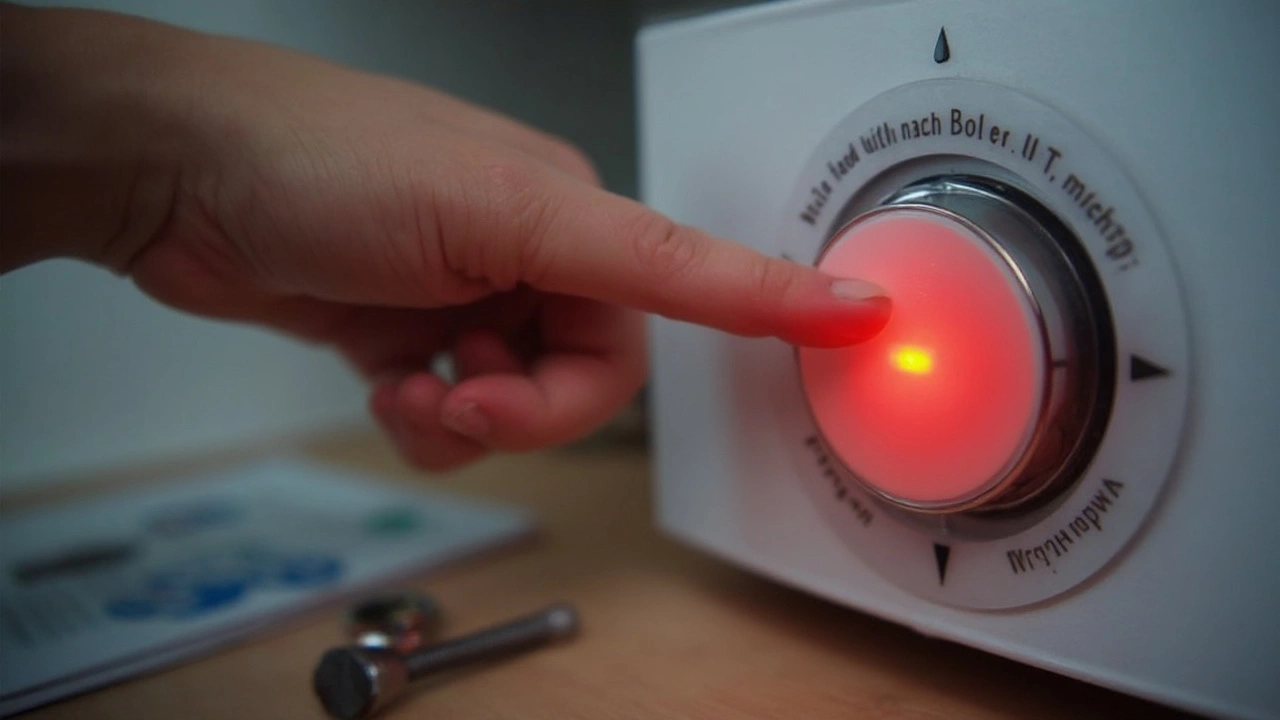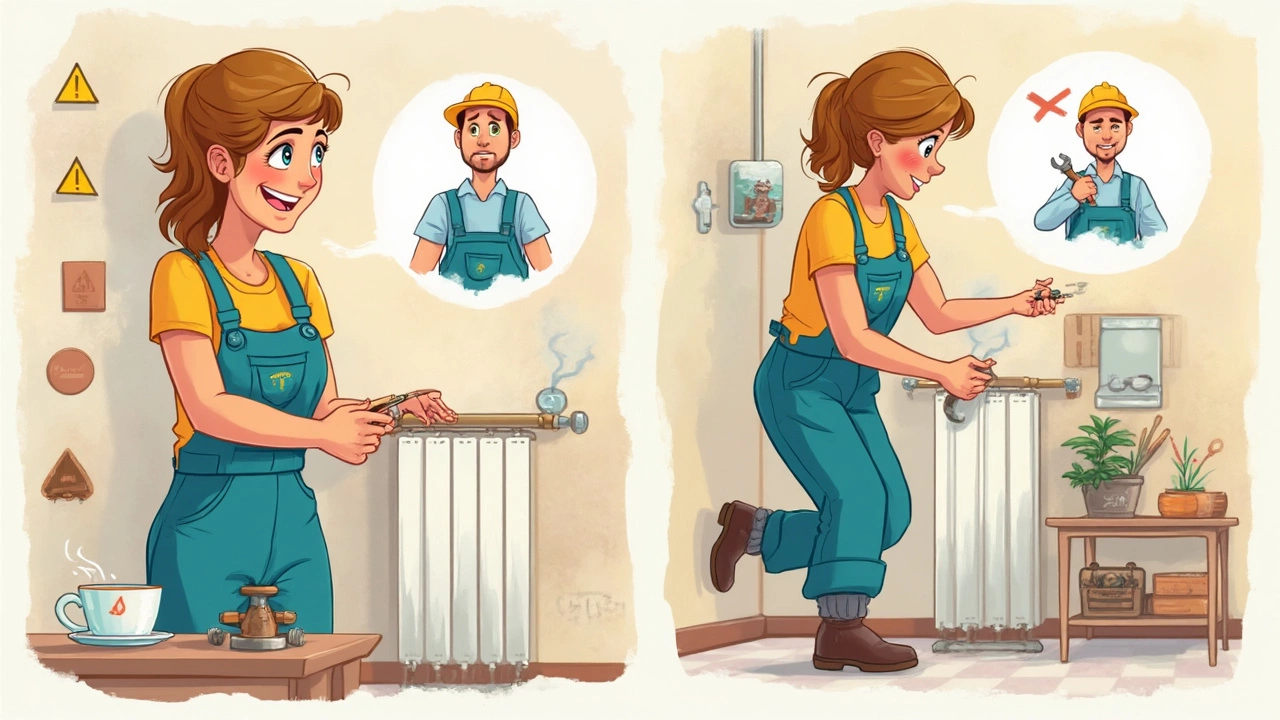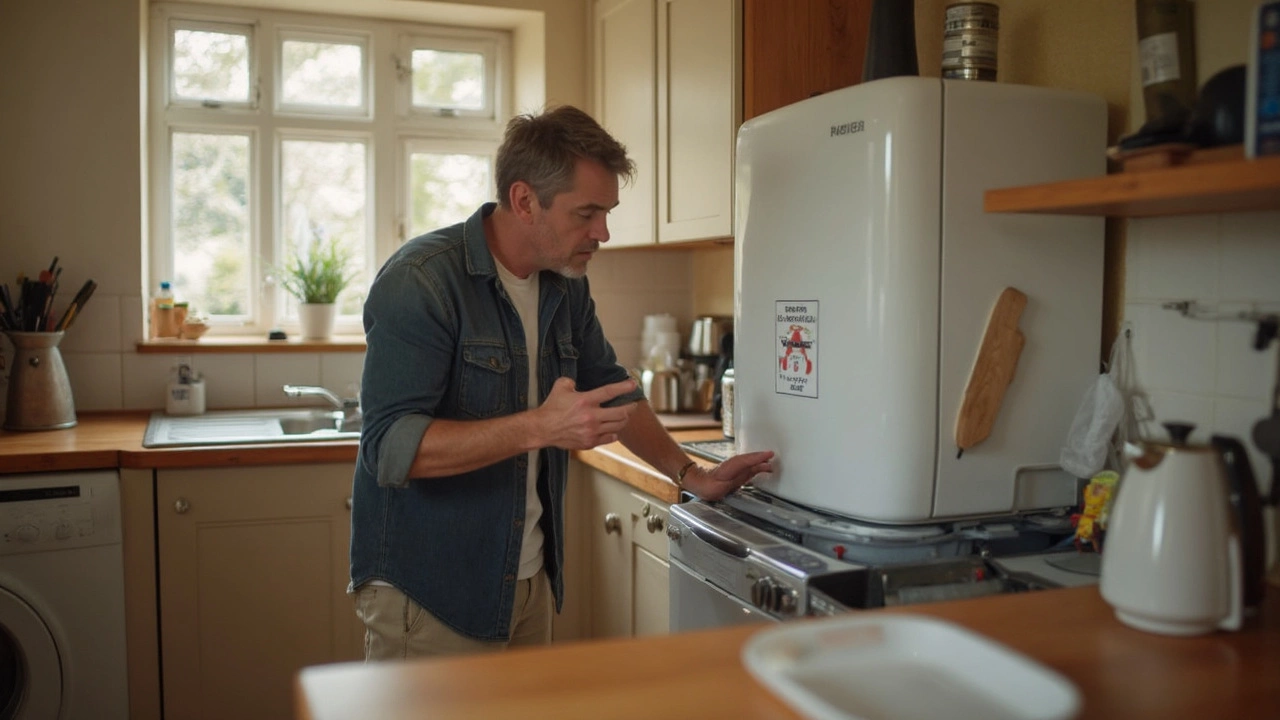You wake up to a cold house. The boiler's acting up—again. Now you're probably thinking, "Can I just fix this thing myself and save the hassle?" It's a tempting idea, but hold on for a second. With boilers, it’s easy to slip from a simple tweak to a risky mistake.
Here’s some straight talk: you can handle a few minor issues, like checking the pressure or bleeding a radiator. Simple tasks like topping up the pressure if it’s dropped below 1 bar, or resetting the boiler if it’s tripped, won’t put you at risk if you follow instructions. But as soon as you’re reaching for a screwdriver to open the boiler casing or messing with gas, that’s when things get dicey. Gas leaks aren’t just scary—they’re dangerous. And by UK law, only Gas Safe-registered engineers should touch anything gas-related inside your boiler. Similar rules apply in the US and most other places.
So, how do you know what’s safe, and what’s a no-go? Keep an eye out for signs like weird noises, water leaks, or the heating coming on and off at random. Sometimes, the fix is as easy as bleeding a radiator or checking for a blocked vent. Don't ignore odd smells—especially that “eggy” gas smell—or a pilot light that's yellow instead of blue. That’s your cue to call for help, not reach for the spanner.
- What Can You Actually Fix Yourself?
- Boiler Jobs That Are Too Risky for DIY
- Common DIY Mistakes (and Why They Happen)
- When It’s Time to Get Professional Help
- Tips for Keeping Your Boiler Healthy
What Can You Actually Fix Yourself?
You don't need to be a heating engineer to sort out a few simple boiler repair problems. A lot of people panic at the first sign of trouble, but there are a few fixes worth trying before you call for backup. Just remember, if you’re not sure, there’s no shame in getting a pro—better safe than sorry when it comes to gas.
Some common issues you can tackle include:
- Repressurizing the boiler: If your boiler’s pressure gauge is below 1 bar, your heating might not work right. Most manuals walk you through topping up the pressure using the filling loop. It’s a straightforward job if you follow the guide—just make sure not to overdo it, or you'll hit the red zone.
- Bleeding radiators: Cold patches in your radiators? That’s trapped air. All you need is a radiator key and a cloth. Turn the valve slowly and let the air out until water dribbles, then close it up. This can save you a bundle and keep your home toasty.
- Resetting the boiler: Sometimes your boiler gets itself in a twist and needs a reset. Press the reset button (look for it, usually on the front) and give it a moment to restart. Don’t keep pressing if nothing happens—move on to professional help if it doesn’t sort itself out.
- Checking for error codes: Modern boilers have error codes on the display. Look up the code in your manual or online. Sometimes it’s something simple, like low pressure or a fault with the thermostat.
- Thermostat troubleshooting: Not all problems are the boiler’s fault. Sometimes, it’s the thermostat batteries, wrong settings, or even a clunky old timer. Try the basics before you assume the boiler itself has packed up.
Here’s a quick snapshot of the jobs safe for DIY boiler fix versus ones to avoid:
| DIY-Friendly | Leave to Professionals |
|---|---|
| Repressurizing boiler | Working inside boiler casing |
| Bleeding radiators | Fixing gas leaks |
| Thermostat checks | Replacing internal parts |
| Resetting boiler | Electrical wiring |
One last tip: always, always turn off the power before you touch anything, and keep your manual handy. If at any point you smell gas or feel out of your depth, step back and call a professional. Trying to fix boiler yourself should never put your safety on the line.
Boiler Jobs That Are Too Risky for DIY
Let’s get to the stuff you definitely shouldn’t handle on your own. Messing around with the inside of your boiler or touching anything to do with gas or electrics is not just a bad idea—it’s actually against the law in a lot of places. If you open that boiler cover and start pulling things apart, you could end up making things worse or risking a major accident. Gas leaks, electric shocks, and even carbon monoxide poisoning are real dangers.
According to Gas Safe Register in the UK, almost half of DIY gas jobs carried out by non-professionals end up being unsafe. That’s not a risk you want to take. Here’s a rundown of boiler repair tasks you should always leave to the pros:
- Gas Valve Repairs – Adjusting or replacing gas valves can easily cause gas leaks, and that’s as risky as it sounds.
- Boiler Servicing or Cleaning Inside the Case – Opening the sealed case usually breaks a safety seal and exposes you to dangerous components.
- Electrical Repairs – Fiddling with internal wiring can knock out your heating, trip your electrics, or even give you a shock.
- Replacement of Key Parts (like Heat Exchangers or Printed Circuit Boards) – These are not just tricky—they’re expensive to replace if you mess up.
- Issues with Flue or Vent Repair – Botched jobs here can trap deadly carbon monoxide in your home.
Just to show how serious this stuff is, check out these stats from reported incidents in 2023:
| DIY Boiler Problem | Reported Incidents | Risk Level |
|---|---|---|
| Gas Leak After DIY Repair | 1,200+ | High |
| Electric Shock | 300+ | High |
| Boiler Failure (after opening case) | 1,500+ | Medium to High |
Even if you’re handy at home, fix boiler yourself is just not worth it when gas or electrics are involved. You don’t just risk breaking the boiler—you could void your home insurance or even face legal trouble. Stick to jobs that are clearly safe, and for the rest, call a certified boiler repair engineer.

Common DIY Mistakes (and Why They Happen)
A lot of folks get tripped up because boilers seem simple until you pop the cover. But even harmless-looking mistakes can mean big trouble for your heating and safety. Let’s break down the usual suspects when it comes to DIY boiler repair blunders.
- Messing with Gas Components: This is the number one risky move. People sometimes try to relight pilot lights, tamper with gas valves, or open the boiler case to find a fault. These steps can lead to gas leaks or carbon monoxide exposure. Only a Gas Safe engineer should touch anything gas related.
- Over-pressurizing the System: Trying to fix low boiler pressure? It’s easy to overshoot and crank it above 2.5 bar, which can cause leaks or even damage the system. The sweet spot is 1 – 1.5 bar when cold.
- Ignoring Leak Signs: Spotting a small drip and thinking “it’ll sort itself” can end up waterlogging expensive circuits inside the boiler. Sometimes the leak looks minor, but it can turn into a short circuit or corrode key parts fast.
- Skipping the Power Switch: Forgetting to turn off the power before working on the boiler is a classic mistake. Boilers might not zap you like open wires, but water plus electricity is never a good mix. Always shut it down at the main switch before touching anything.
- Using Wrong Replacement Parts: Off-brand or non-matching parts found online may seem like a quick fix, but they can void your warranty and cause more damage. Boilers aren’t like IKEA furniture—parts need to fit exactly or the whole system’s at risk.
According to a 2023 UK government safety report, about 16% of all reported boiler accidents in homes came from unauthorized DIY repairs. That covers fires, leaks, or full breakdowns after homeowners tried to “have a go.”
| Common DIY Boiler Mistake | Potential Consequence |
|---|---|
| Over-pressuring system | Leaking pipes, system damage |
| Opening sealed components | Gas leaks, invalid warranty |
| Wrong parts used | System failure, safety risk |
| Ignoring leaks | Electrical shorts, corrosion |
If you’re unsure, just stop. Trying to save a few quid can end up costing hundreds—or put your whole house at risk. Whenever you feel out of your depth or the manual starts speaking in riddles, that’s your sign to get a boiler repair pro involved.
When It’s Time to Get Professional Help
Let’s be straight: there’s a line you shouldn’t cross when it comes to boiler repair. Some problems go way beyond what you can fix with a YouTube video and a bit of DIY confidence. In fact, about 70% of boiler breakdowns involve stuff that's actually illegal or unsafe for unqualified folks to touch.
- Gas leaks or the smell of gas: If you even get a whiff of gas, switch the boiler off, open windows, and call your gas provider or emergency services. Don’t try to fix this yourself. A boiler repair expert has special tools to find and fix leaks safely.
- Strange noises inside the boiler: Clanking, banging, or whistling (sometimes called "kettling") can mean scale buildup or a failing heat exchanger. That’s not a quick fix—it needs a pro.
- Persistent low pressure: If you keep topping up the pressure and it keeps dropping, there’s probably a leak somewhere in the system that’s not visible. A qualified engineer can track this down using pressure tests.
- Water leaks from the boiler unit: Leaking water inside the casing is a red flag. This can cause electrical shorts or corrosion. Leave it and call for professional boiler repair before it turns into a bigger issue.
- Pilot light keeps going out or burns yellow: A yellow light or one that refuses to stay on can mean carbon monoxide's being produced. This is super dangerous—no fixing this yourself.
- Error codes you can't clear: Modern boilers throw out fault codes. If a reset won't clear it, check your manual. But if the code stays, it’s time for an engineer.
There’s also the law. In the UK, anyone working on gas inside boilers must be Gas Safe registered. Breaking that rule not only puts you in danger, but can void warranties, screw up home insurance claims, and risk criminal charges. In the US, the law usually says only licensed professionals can work on gas plumbing. Insurance won’t pay out if you’ve bodged something yourself.
| Situation | DIY Allowed? | Call a Pro? |
|---|---|---|
| Bleeding radiators | Yes | No |
| Topping up pressure | Yes | No |
| Opening boiler casing | No | Yes |
| Fixing gas leaks | No | Yes |
| Replacing parts inside boiler | No | Yes |
The bottom line: if your boiler repair seems like more than a simple tweak, call in a professional. They’ll diagnose it with the right gear and fix it properly, keeping your home (and your bank balance) safe.

Tips for Keeping Your Boiler Healthy
If you want to sidestep constant boiler repair bills, a little routine care goes a long way. Most breakdowns happen because people skip the basics. Here’s what actually works for keeping your boiler running well—and keeping your house warm when you need it.
- Annual Service: Don’t skip this. Book a yearly service with a qualified engineer. They’ll spot tiny issues before they turn into expensive problems, and it keeps your warranty valid. Skipping a service can cause efficiency to drop by 10-15% in just a few years.
- Check Your Pressure Regularly: Most boilers are happy around 1 to 1.5 bar. If your gauge is showing less or more, your system won’t run right. Top it up with the filling loop if it’s low, or call someone if it’s always dropping.
- Bleed Your Radiators: If rooms feel cold even when the radiator’s hot at the bottom, air might be trapped inside. Use a radiator key to release the air so your heating works efficiently. Just keep a towel handy for drips.
- Keep Vents and Flues Clear: Blocked vents or flues force your boiler to work harder and can be unsafe. Clear away any clutter indoors and check outside, especially if you’ve got bushes or leaves growing up around the flue.
- Look for Warning Signs: Odd noises, leaks, or a yellow pilot light mean stop using the boiler and get it checked. Don’t DIY fixes if you spot these.
Ever wonder how often people skip maintenance? A study in the UK found that nearly 40% of homeowners delay servicing their boiler past the recommended yearly check. That’s a lot of potential breakdowns waiting to happen.
| Maintenance Task | How Often? |
|---|---|
| Annual Service | Every 12 months |
| Bleed Radiators | Once a year or when cold spots appear |
| Check Boiler Pressure | Once a month |
Last thing—always keep your boiler’s user manual handy. It’ll have handy troubleshooting flowcharts for your specific model. If something feels off, trust your gut and get a pro in. Prevention beats pricey boiler repair every time.


